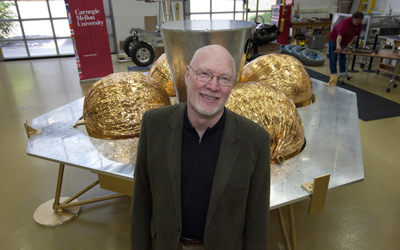Press Release: Carnegie Mellon Roboticist “Red” Whittaker To Receive 2012 IEEE Simon Ramo Medal
Cited For Developing Robots That Work in Challenging, Dangerous Places
Contact: Byron Spice / 412-268-9068 / bspice@cs.cmu.edu
 PITTSBURGH—William “Red” Whittaker, who has repeatedly developed robots to work in such inhospitable places as contaminated nuclear plants, abandoned mines, active volcanoes, Antarctic glaciers and the moon, has been awarded the 2012 Simon Ramo Medal by IEEE, the world’s largest technical professional organization.
PITTSBURGH—William “Red” Whittaker, who has repeatedly developed robots to work in such inhospitable places as contaminated nuclear plants, abandoned mines, active volcanoes, Antarctic glaciers and the moon, has been awarded the 2012 Simon Ramo Medal by IEEE, the world’s largest technical professional organization.
Whittaker, a University Professor in Carnegie Mellon University’s Robotics Institute, will receive the medal at the IEEE Honors Ceremony in Boston, Mass., on June 30. The medal, sponsored by Northrop Grumman Corporation, recognizes Whittaker for his pioneering contributions to mobile autonomous robotics, field applications of robotics and systems engineering.
“For decades now, Red has been the leader in moving robots out of laboratories and factories and into unpredictable, sometimes hazardous environments,” said Matt Mason, director of the Carnegie Mellon Robotics Institute. “His combination of engineering insight, technical rigor and audacity has enabled him to make things as complex as robots work, and work well, in places as varied as deserts, mines, nuclear plants, ice sheets and other planets.”
Whittaker’s reputation as the father of field robotics began to grow in the mid-1980s, when he and his CMU team developed robots to inspect and perform repairs in the basement of the damaged Three Mile Island nuclear reactor near Harrisburg, Pa. He overcame challenges including the extreme environment and the high level of reliability needed because of the inability of humans to enter the contaminated area if robot maintenance was required. These efforts led to the creation of the Robotics Institute’s Field Robotics Center, which Whittaker directs.
He has developed more than 60 robots, including Dante II, a walking robot that explored an active volcano; Nomad, which searched for meteorites in Antarctica; and Tugbot, which surveyed an 1,800-acre area of Nevada for buried hazards. He led CMU’s Tartan Racing team that developed the self-driving SUV called Boss that won the 2007 Urban Challenge road race for robots. He has pioneered the locomotion technologies, navigation and route-planning methods and advanced sensing systems that make these robots successful.
His current focus is Astrobotic Technology, a CMU spinoff firm that is developing space robotics technology to support planetary missions and organizing a commercial venture to land a robot on the moon in 2015. He also founded two other spinoff companies — RedZone Robotics and Workhorse Technologies — and the Robotics Institute’s National Robotics Engineering Center.
Earlier this year, the American Society of Civil Engineers awarded Whittaker its 2012 Columbia Medal, which recognizes sustained outstanding contributions to the advancement of aerospace engineering. Last year, the Association for the Advancement of Artificial Intelligence presented him its inaugural Feigenbaum Prize for his work in autonomous vehicle research. Other honors include Fortune magazine’s Hero of Manufacturing (1999), the Joseph Engelberger Award for Achievement in Robotics (2006) and the Carnegie Science Center Catalyst Award (2006).
Whittaker received his bachelor’s degree in civil engineering from Princeton University, and master’s and doctorate degrees in civil engineering from Carnegie Mellon. In 2007, he was named a University Professor, the highest distinction faculty can achieve at Carnegie Mellon.
###
Above: Red Whittaker and Griffin, a spacecraft built to deliver a robot to the moon in 2015.